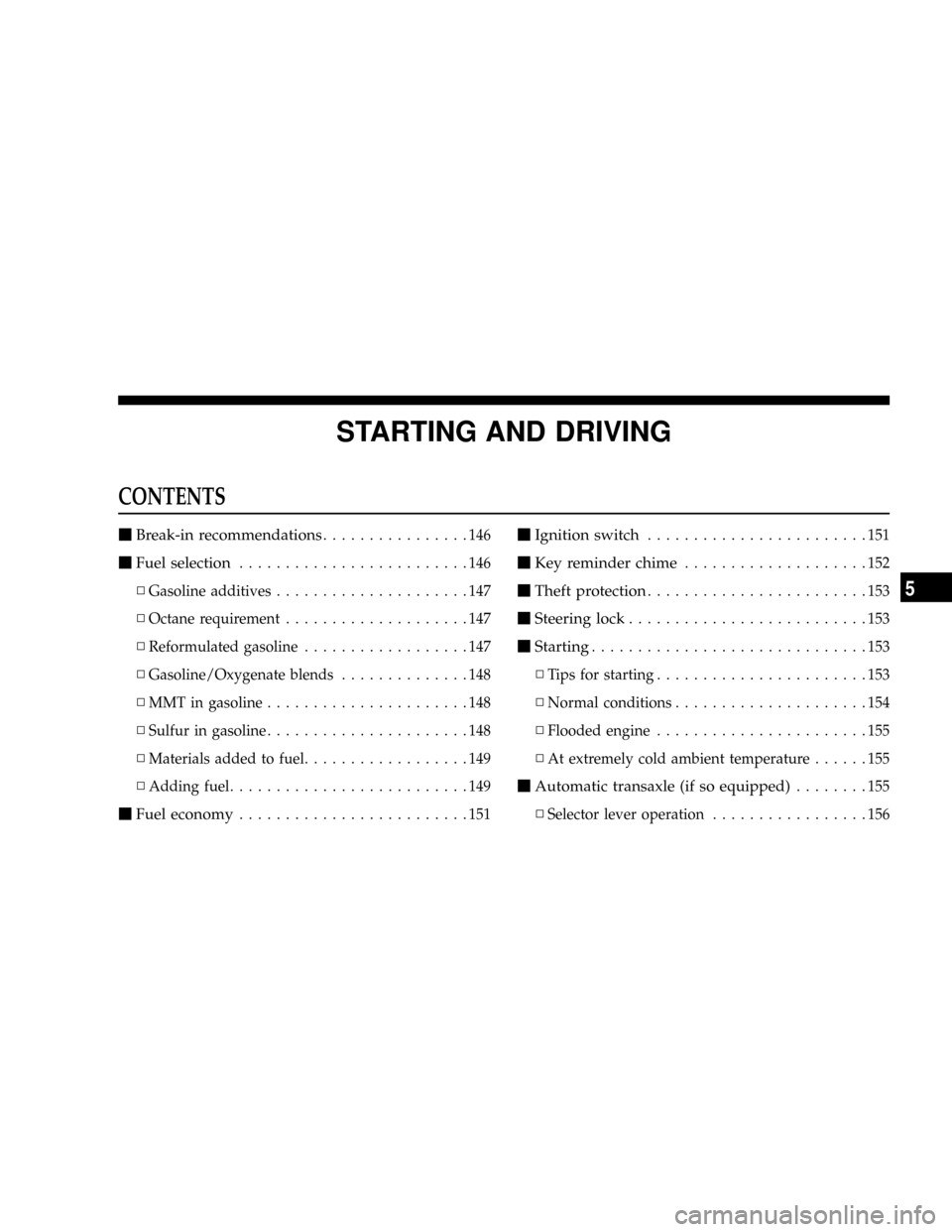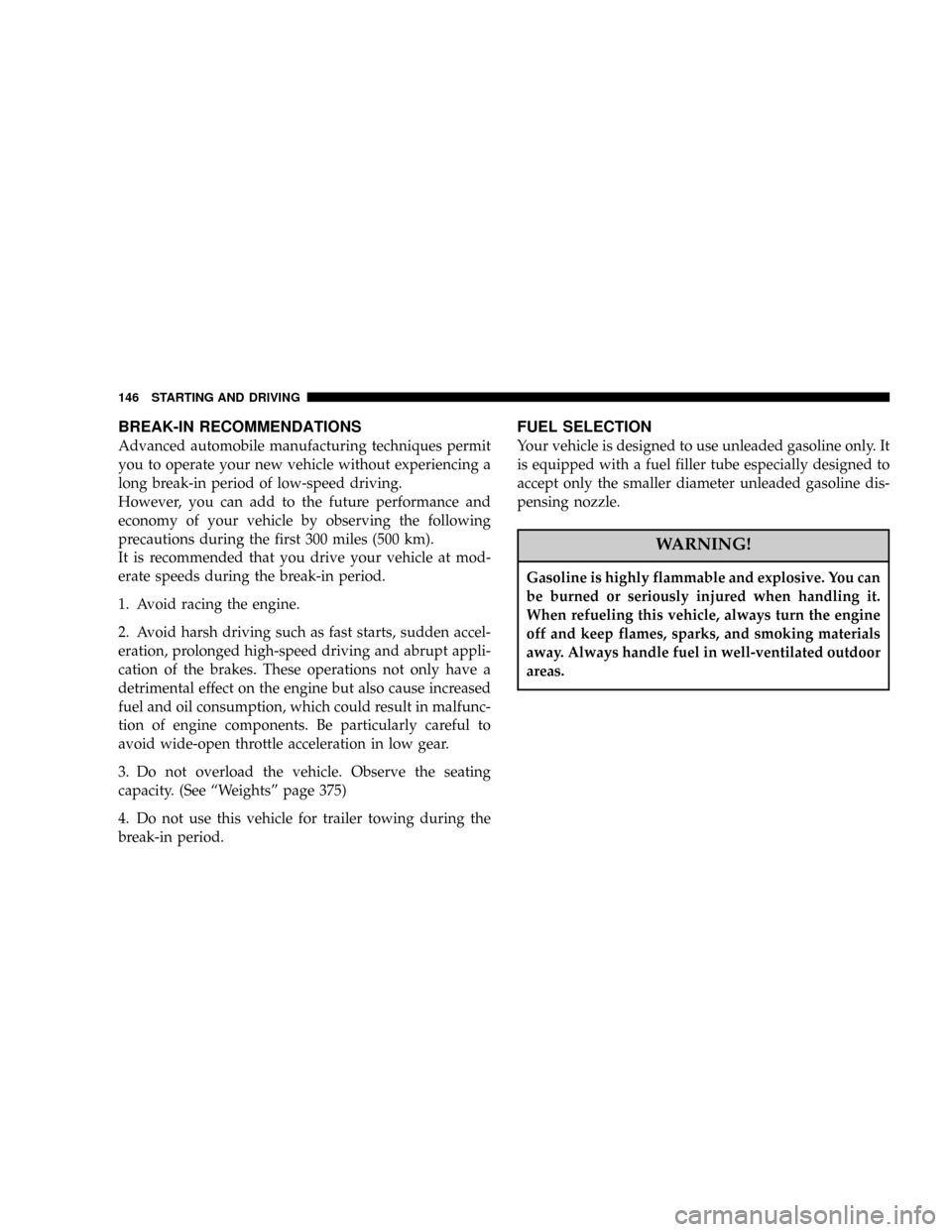Page 109 of 396
Indicator and warning light package
1. Washer fluid level indicator!P. 121
2. Anti-lock braking system warning light
(if so equipped)!P. 1 1 5
3. Low-fuel warning light!P. 1 1 5
4. Brake warning light!P. 1 1 95. Supplemental Restraint System (SRS) - air bag
warning light!P. 1 1 8
6. Seat belt reminder/warning light!P. 120
7. Turn signal indicators/hazard warning light!P. 1 1 4
8. Trunk-ajar warning light!P115
9. Front fog light indicator!P. 1 1 6
10. Door-ajar warning light!P. 1 1 4
D50A439D
INSTRUMENTS AND CONTROLS 109
4
Page 111 of 396
CAUTION!
The red zone indicates an engine speed in excess of
safe operation.
Select the correct gear to control engine speed so the
tachometer indicator does not enter the red zone.
Fuel gauge
The gauge shows the amount of fuel in the fuel tank
when the ignition key is turned to the ``on'' position.
The arrow A indicates that the fuel lid (fuel filler port) is
located on the right side of the vehicle. (Refer to ªFuel
fillerº on page 39.)
NOTE: Just after refueling, it takes a little time until the
correct fuel level is indicated after turning on the ignition
switch.
D05A0770
INSTRUMENTS AND CONTROLS 111
4
Page 115 of 396

Trunk-ajar warning light and chime
This light illuminates when the trunk lid is
open or not completely closed.
When the vehicle is moving at more than 5
mph (8 km/h) and the trunk lid is open or
ajar, a chime will sound to inform the driver that the
trunk lid is not properly shut.
Anti-lock braking system warning light (if so
equipped)
This light comes on in the event of a mal-
function in the anti-lock braking system.
Always be sure that the light goes out
before beginning to drive.
It also comes on when the ignition key is turned to the
ªONº position and should go out shortly after starting
the engine.
If the light illuminates during driving;
1. Stop the vehicle in a safe place and turn off the engine.
Test the system by restarting the engine and driving at a
speed of about 12 mph (20 km/h) or higher.
If the light goes out, there is no abnormal condition.2. If the light does not go out or if it illuminates again,
the anti-lock braking system is not functioning, and only
the standard braking system is functioning.
If this occurs, take your vehicle to an authorized dealer
and have the system checked.
NOTE: If the light remains illuminated after the engine
is started, it indicates that a fault has occured in the
Anti-lock brake system. The standard brake system will
function normally. (Refer to ªAnti-lock braking systemº
on page 175).
Cruise/speed control indicator
This indicator will illuminate when the
cruise/speed control main switch is ªONº.
Low-fuel warning light and chime
When the fuel level in the fuel tank gets
low, the light illuminates and the chime will
also sound. It is recommended that fuel be
added as soon as this light illuminates.
INSTRUMENTS AND CONTROLS 115
4
Page 116 of 396

CAUTION!
Do not drive with an extremely low fuel level;
running out of fuel could cause damage to the
catalytic converter.
Front fog light indicator (if so equipped)
This indicator illuminates while the fog
lights are on.
NOTE:Fog lights will not be operational when high
beam (headlights) are selected.
Charging system warning light
This light illuminates in the event of a
malfunction in the charging system.
This light illuminates when the ignition key
is turned to the ªONº position (engine off). When the
engine is started, the light should go off. Always be sure
that the light goes out before beginning to drive.
CAUTION!
If the charging light remains on after the engine has
started, the battery charging system may be malfunc-
tioning. In this case, take your vehicle to an autho-
rized dealer and have the system checked.
Oil pressure warning light
This light illuminates when the engine oil
pressure is below normal. If the light stays
on while driving, stop the engine as soon as possible and
do not drive until the cause of the low oil pressure is
corrected.
116 INSTRUMENTS AND CONTROLS
Page 118 of 396

CAUTION!
²Prolonged driving with the malfunction indicator
light on may result in further damage to the
emission control system. Continued driving could
also affect fuel economy and driveability.
²If the light does not illuminate when the ignition
key is turned to the ªONº position (bulb check),
have the system checked at an authorized dealer.
NOTE: Do not disconnect the battery cable when the
Malfunction indicator light (SERVICE ENGINE SOON) is
ON.
The engine electronic control module stores critical OBD
data, which may be lost if the battery is disconnected.
This can make rapid diagnosis more difficult.
If the fuel tank filler cap is not secured properly, the
light may come on. Be sure the fuel tank filler tube cap
is tightened every time you add fuel. (Turn the fuel
tank filler cap clockwise until you hear clicking
sounds.)Overheating warning light
If the warning light illuminates while the
engine is running, it is possible that the
engine is overheated.
Immediately park your vehicle in a safe
place and make the necessary corrections.
(Refer to ``Engine overheating'' on page 279.)
While driving, care should always be taken to maintain
the normal operating temperature.
Supplemental Restraint System (SRS)-air bag
warning light
This light illuminates when the Supplemen-
tal Restraint System-air bag is not working
properly. It will also illuminate for about 7
seconds after the ignition key is turned to the ªONº
position or after the engine is started. The light should
then go out.
Check the light every time the vehicle is started.
If it does not illuminate, or stays on for more than
approximately 7 seconds after the ignition key is turned
ªONº or after the engine is started, or if it comes on while
118 INSTRUMENTS AND CONTROLS
Page 143 of 396

STARTING AND DRIVING
CONTENTS
mBreak-in recommendations................146
mFuel selection.........................146
NGasoline additives.....................147
NOctane requirement....................147
NReformulated gasoline..................147
NGasoline/Oxygenate blends..............148
NMMT in gasoline......................148
NSulfur in gasoline......................148
NMaterials added to fuel..................149
NAdding fuel..........................149
mFuel economy.........................151
mIgnition switch........................151
mKey reminder chime....................152
mTheft protection........................153
mSteering lock..........................153
mStarting..............................153
NTips for starting.......................153
NNormal conditions.....................154
NFlooded engine.......................155
NAt extremely cold ambient temperature......155
mAutomatic transaxle (if so equipped)........155
NSelector lever operation.................156
5
Page 146 of 396

BREAK-IN RECOMMENDATIONS
Advanced automobile manufacturing techniques permit
you to operate your new vehicle without experiencing a
long break-in period of low-speed driving.
However, you can add to the future performance and
economy of your vehicle by observing the following
precautions during the first 300 miles (500 km).
It is recommended that you drive your vehicle at mod-
erate speeds during the break-in period.
1. Avoid racing the engine.
2. Avoid harsh driving such as fast starts, sudden accel-
eration, prolonged high-speed driving and abrupt appli-
cation of the brakes. These operations not only have a
detrimental effect on the engine but also cause increased
fuel and oil consumption, which could result in malfunc-
tion of engine components. Be particularly careful to
avoid wide-open throttle acceleration in low gear.
3. Do not overload the vehicle. Observe the seating
capacity. (See ªWeightsº page 375)
4. Do not use this vehicle for trailer towing during the
break-in period.
FUEL SELECTION
Your vehicle is designed to use unleaded gasoline only. It
is equipped with a fuel filler tube especially designed to
accept only the smaller diameter unleaded gasoline dis-
pensing nozzle.
WARNING!
Gasoline is highly flammable and explosive. You can
be burned or seriously injured when handling it.
When refueling this vehicle, always turn the engine
off and keep flames, sparks, and smoking materials
away. Always handle fuel in well-ventilated outdoor
areas.
146 STARTING AND DRIVING
Page 147 of 396

CAUTION!
Using leaded gasoline in your vehicle will damage
the engine, catalytic converter, and the oxygen sen-
sors. Further, using leaded gasoline is illegal, and
will void warranty coverage of the engine, catalytic
converter, and oxygen sensors.
Gasoline additives
Many fuel suppliers add detergents to their gasoline to
minimize fuel injector fouling and to control intake valve
deposits. These detergent gasolines are highly recom-
mended for use in your vehicle. They help keep your
engine in tune and your emission control system working
properly.
Octane requirement
2.4 liter engine model
Your vehicle is designed to operate on unleaded gasoline
having a minimum octane rating of 87 [(MON+RON)/2],
or 91 RON.
3.0 liter engine model
Your vehicle is designed to operate on regular grade
unleaded gasoline having a minimum octane rating of 87
[(MON+RON)/2], or 91 RON. If optimum performance
is wanted, it is recommended to use premium grade
unleaded gasoline having an octane rating of 91
[(MON+RON)/2], or 95 RON.
MON: Motor Octane Number
RON: Research Octane Number
Reformulated Gasoline
Many areas of the country require the use of cleaner
burning fuel referred to as ªReformulated Gasolineº.
Reformulated gasolines contain oxygenates, and are spe-
cially blended to reduce vehicle emissions and improve
air quality.
The manufacturer supports the use of reformulated gaso-
lines. Properly blended reformulated gasolines will pro-
vide excellent performance and durability of engine and
fuel system components.
STARTING AND DRIVING 147
5